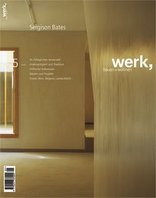Zeitschrift
werk, bauen + wohnen 5-05
Sergison Bates
We experience the buildings by Jonathan Sergison and Stephen Bates as both familiar and alien. Their tendency towards simple forms and a certain sparseness, the care with which they use construction as a means of expression, and their respect for the places that they alter with their interventions - all this paves the way to an understanding of their work. However, the specific context in which they work and from which they draw their inspiration is comparatively alien. For example, in Switzerland we lack a comparable brick culture that is important to much of their work. And the frequently small-scale spatial density of their buildings that we find so fascinating is probably partially derived form the London environment, where the economic situation simply does not permit the sheer size with which we in Switzerland are familiar. Their work bears witness to a certain tenderness in their dealings with everyday, commonplace situations. It appears to have more to do with the maximum, including maximal complexity, than with any kind of minimalism, and certainly than with any rhetoric of crudeness and banality. It is therefore not surprising that although the work of Peter and Alison Smith is cited as a reference, the buildings of the Cambridge School with its unambiguous declaration of architecture as the art of building are mentioned at the same time, including Kettle's Yard with its refined merging of art and everyday life. They will be discussed in this issue, partly because they contribute to an understanding of Sergison Bates, and partly because discoveries of things not so well-known in Switzerland can be made. It is with good reason that Bruno Krucker speaks of realism in his article. Albeit with a certain lightness, but seriously, and above all without irony, this realism affirms the concreteness and conditionality of architecture and derives from it benefit for a kind of architecture that is aware of its history and its autonomy. This sort of realism is constantly of topical interest in the history of architecture; in Switzerland, the last time was at the end of the 1970s, when new forces began to crystallise out of the identity crisis of an increasingly stagnant modernity. „Every art needs the fountain of youth of realism from time to time if it is not to become paralysed“, wrote the great architect and teacher Theodor Fischer in 1918. This would also appear to be worthy of consideration today, when a certain perfectionism has become routine, when different formalisms compete for attention without entering into competition with one another, and when would-be utopian projects cast doubt upon themselves through their latent irony even before they seriously dream about a better world. Against this background, the work of Sergison Bates takes on an altogether different aspect: more commonplace and modest, but also more authentic.
The editors
Thema
Bruno Krucker
Im Alltäglichen verwurzelt | Bemerkungen zur Architektur von Jonathan Sergison und Stephen Bates
Jonathan Sergison
Ausblicke
Irina Davidovici
Andersartigkeit und Tradition | Zur Genealogie der Differenz in der modernen britischen Architektur
Jonathan Sergison und Stephen Bates
Hilfreiche Referenzen
Jonathan Sergison und Stephen Bates
4 Projekte:
Sanierung und Erweiterung mit Mischnutzung, Wandsworth, Londen;
Studiohaus, Bethnal Green, Lond0n;
Royal Arsenal Masterplan, Woolwich, London;
Das Kulturgeschichtliche Museum von Bornholm, Dänemark
Biografie, Projekte 1996 -2005, Bibliografie
Forum
Kolumne:Christina von Braun
Wettbewerb: Internationaler Wettbewerb für ein
neues Musée cantonal des Beaux-Arts in Lausanne
Texte original français
EFH: Haus Binswanger,Landschlacht,von Beat Consoni
Bauten: Atelierhaus Huber in Emmenbrücke, von Graser Architekten AG, Zürich
Bauten: Zweifamilienhaus «Faraday » in Bern, von
Thomas Jomini architecture workshop, Bernund
Jomini &Zimmermann Architekten,Burgdorf
Ausstellung und Katalog «Konstruktive Provokation
» zur Vorarlberger Architekturszene im Kunsthaus
Bregenz
bauen +rechten
Architekturausstellungen | Veranstaltungen |
Wettbewerbe| Neuerscheinungen | Produkte
werk-Material
Graser Architekten AG, Zürich: Atelierhaus Huber, Emmenbrücke
Thomas Jomini architecture workshop, Bern und Jomini & Zimmermann
architekten, Burgdorf: Zweifamilienhaus «Faraday », Bern
The editors
Thema
Bruno Krucker
Im Alltäglichen verwurzelt | Bemerkungen zur Architektur von Jonathan Sergison und Stephen Bates
Jonathan Sergison
Ausblicke
Irina Davidovici
Andersartigkeit und Tradition | Zur Genealogie der Differenz in der modernen britischen Architektur
Jonathan Sergison und Stephen Bates
Hilfreiche Referenzen
Jonathan Sergison und Stephen Bates
4 Projekte:
Sanierung und Erweiterung mit Mischnutzung, Wandsworth, Londen;
Studiohaus, Bethnal Green, Lond0n;
Royal Arsenal Masterplan, Woolwich, London;
Das Kulturgeschichtliche Museum von Bornholm, Dänemark
Biografie, Projekte 1996 -2005, Bibliografie
Forum
Kolumne:Christina von Braun
Wettbewerb: Internationaler Wettbewerb für ein
neues Musée cantonal des Beaux-Arts in Lausanne
Texte original français
EFH: Haus Binswanger,Landschlacht,von Beat Consoni
Bauten: Atelierhaus Huber in Emmenbrücke, von Graser Architekten AG, Zürich
Bauten: Zweifamilienhaus «Faraday » in Bern, von
Thomas Jomini architecture workshop, Bernund
Jomini &Zimmermann Architekten,Burgdorf
Ausstellung und Katalog «Konstruktive Provokation
» zur Vorarlberger Architekturszene im Kunsthaus
Bregenz
bauen +rechten
Architekturausstellungen | Veranstaltungen |
Wettbewerbe| Neuerscheinungen | Produkte
werk-Material
Graser Architekten AG, Zürich: Atelierhaus Huber, Emmenbrücke
Thomas Jomini architecture workshop, Bern und Jomini & Zimmermann
architekten, Burgdorf: Zweifamilienhaus «Faraday », Bern
Weiterführende Links:
Verlag Werk AG







